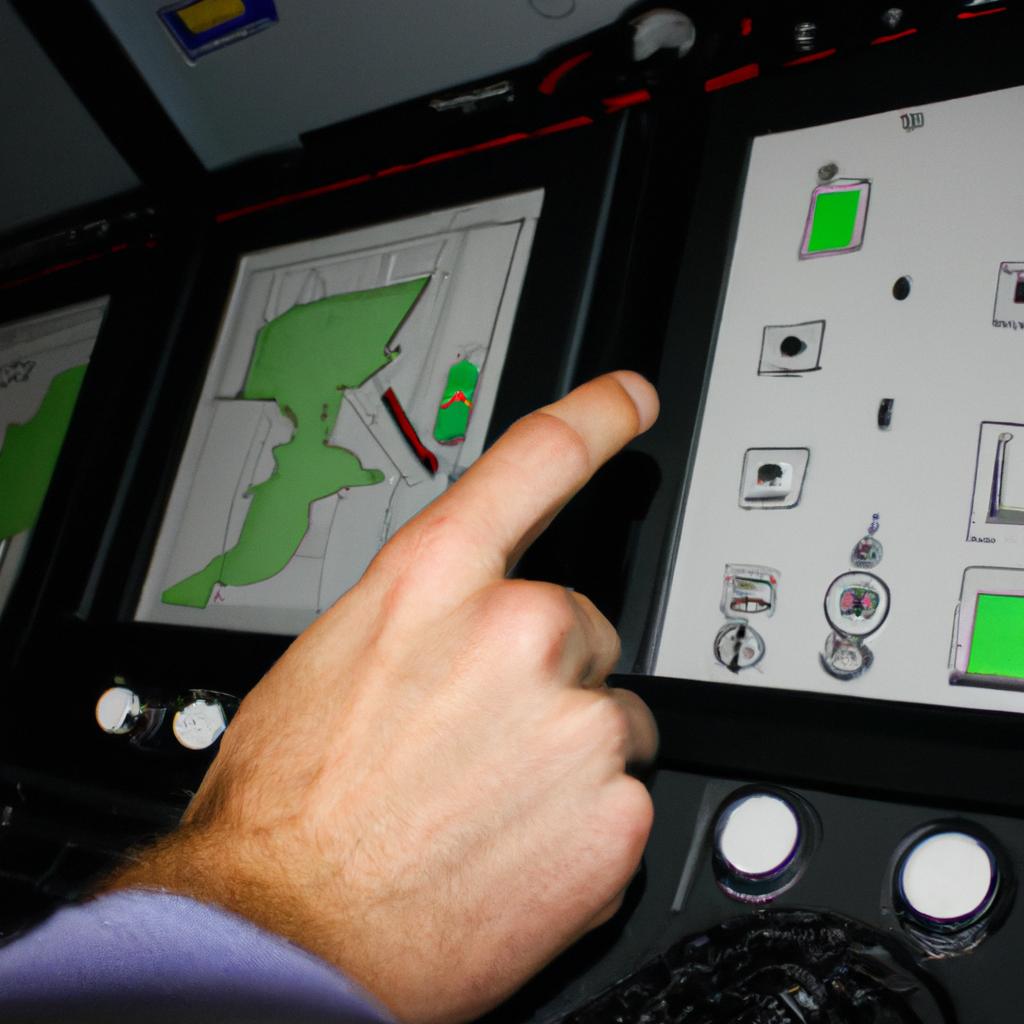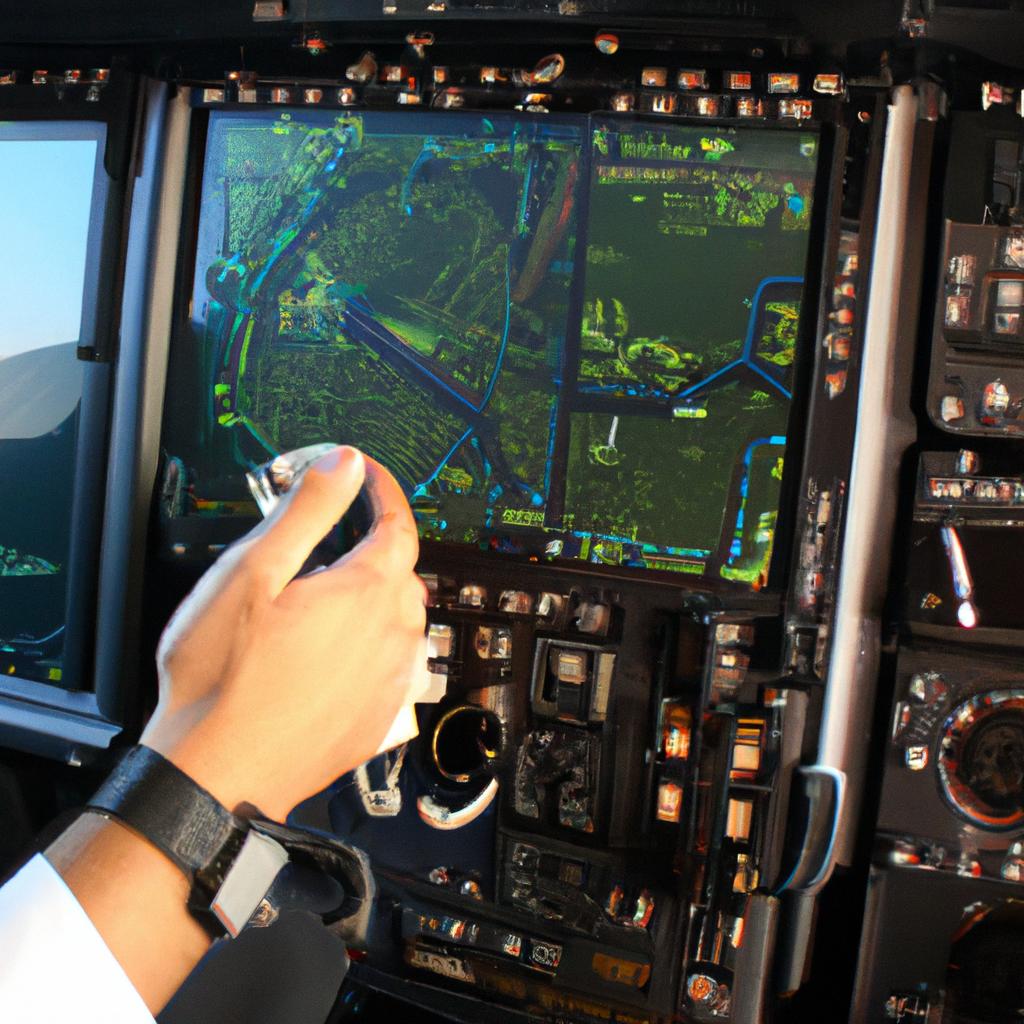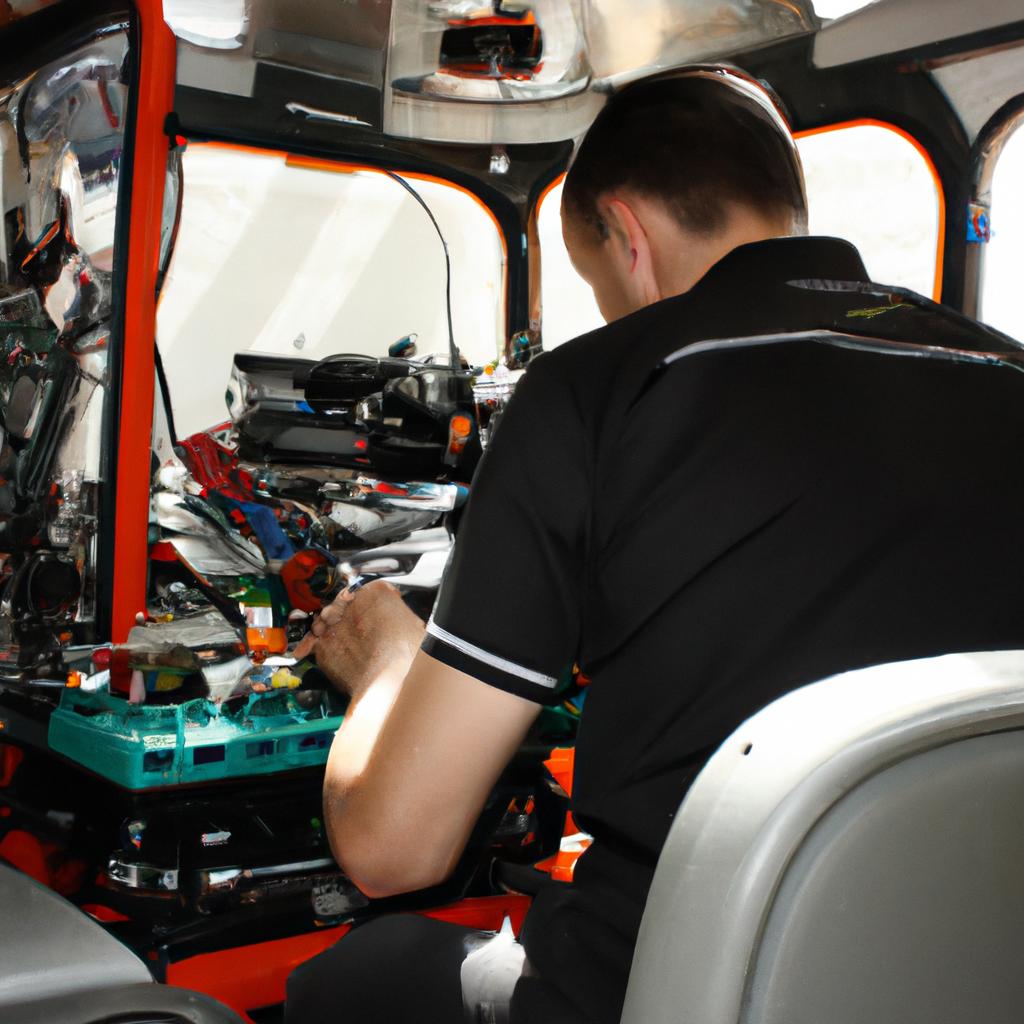Inertial Navigation System (INS) is a crucial component of aerospace and defense avionics, offering accurate and reliable navigation capabilities to various aircraft platforms. One notable case study that highlights the significance of INS in the field of aviation is its utilization by NASA’s Mars Rover missions. The Curiosity rover, which landed on Mars in 2012, relied heavily on an advanced INS to navigate through the challenging Martian terrain and conduct scientific exploration.
The aerospace industry has long recognized the importance of precise positioning, velocity estimation, and attitude determination for flight safety and mission success. Inertial Navigation Systems have emerged as a key solution in this regard, utilizing accelerometers and gyroscopes to measure acceleration forces and angular rates experienced by an aircraft or spacecraft. By integrating these measurements over time, INS can accurately estimate position, velocity, and orientation relative to an initial reference point or coordinate system. This article aims to provide a comprehensive overview of inertial navigation systems’ principles of operation, their applications within the aerospace and defense sector, advancements made in recent years, as well as challenges faced in implementing this technology on a larger scale.
What is an Inertial Navigation System?
Imagine a fighter jet soaring through the sky at supersonic speeds, maneuvering swiftly and accurately to hit its target. How does it navigate with such precision? The answer lies in the sophisticated technology of an Inertial Navigation System (INS). An INS is a critical component used in aerospace and defense avionics that enables precise positioning, attitude determination, and navigation capabilities for various platforms, including aircraft, missiles, submarines, and spacecraft.
To understand the functionality of an INS, let us explore its key components. Firstly, an INS consists of accelerometers that measure linear acceleration along different axes. These sensors detect changes in velocity and provide inputs necessary for determining position and velocity information. Secondly, gyroscopes are employed to measure angular rotation rates around each axis. By precisely tracking these rotations, an INS can determine orientation or attitude relative to a reference frame. Lastly, data from both accelerometers and gyroscopes are processed by advanced algorithms within the system’s computer unit to calculate accurate position updates continuously.
The advantages offered by an INS extend beyond traditional navigation systems like Global Positioning Systems (GPS), especially in scenarios where GPS signals may be unreliable or unavailable due to intentional jamming or natural interference. Here are some notable benefits:
- Autonomous Operation: Unlike GPS-dependent systems, an INS operates autonomously without relying on external signals.
- High Accuracy: With highly sensitive sensors and complex algorithms, an INS provides precise location information even in challenging environments.
- Rapid Updates: An INS can rapidly update position data multiple times per second, enabling real-time decision-making.
- Redundancy: In mission-critical applications such as military operations or space exploration missions where failure is not an option, redundancy ensures backup systems take over seamlessly if primary systems fail.
| Advantages of Inertial Navigation Systems |
|---|
| Autonomous Operation |
| Operates independently without external signals |
In conclusion, an Inertial Navigation System is a vital technology that enables accurate positioning and navigation capabilities for aerospace and defense applications. By utilizing accelerometers, gyroscopes, and advanced algorithms, an INS offers autonomous operation, high accuracy, rapid updates, and system redundancy. Understanding the fundamentals of how an INS functions will shed light on its broader implications in the field of avionics.
Next, let us explore how an Inertial Navigation System works to achieve such remarkable feats of navigational precision.
How does an Inertial Navigation System work?
Inertial Navigation System (INS) is a crucial component of aerospace and defense avionics, providing accurate position, velocity, and attitude information for various applications. To further understand the significance of INS, let’s consider an example scenario in which an aircraft equipped with this system encounters severe weather conditions while navigating through unfamiliar terrain. In such a situation, the INS can play a vital role by continuously updating the aircraft’s position and guiding it safely to its destination.
One fundamental aspect of an INS is its ability to determine position and orientation using internal sensors without relying on external references like GPS or ground-based navigational aids. This self-contained nature makes it highly reliable even in environments where signals might be jammed or inaccessible. The working principle behind an INS involves employing accelerometers to measure changes in velocity and gyroscopes to detect angular rotations. By integrating these measurements over time, the system calculates precise positioning data relative to its initial starting point.
The accuracy and robustness offered by an INS have made it indispensable in numerous aerospace applications. Let us explore some key advantages that make this technology so valuable:
- Continuous operation: An INS operates autonomously without dependence on external infrastructure or factors such as satellite coverage or radio signals. This ensures uninterrupted navigation capabilities regardless of location.
- Real-time updates: The system provides real-time feedback about the vehicle’s position, velocity, and heading, enabling pilots or operators to make informed decisions promptly.
- Improved safety: By offering accurate positional awareness even when other systems may fail or provide unreliable data, an INS enhances situational awareness for pilots during critical maneuvers or emergency situations.
- Reduction in size and weight: Modern advancements in microelectromechanical systems (MEMS) technology have led to miniaturized inertial sensors suitable for integration into smaller platforms such as unmanned aerial vehicles (UAVs), thereby enhancing their operational capabilities.
| Advantages of Using Inertial Navigation System in Aerospace |
|---|
| Continuous operation |
As evident from the aforementioned advantages, an INS proves to be a valuable asset in aerospace and defense avionics. In the subsequent section, we will delve into the specific benefits of utilizing this navigation system in various applications, including aircraft, spacecraft, and missiles. By comprehending these advantages, one can appreciate how INS technology revolutionizes navigation within the aerospace industry.
Advantages of using Inertial Navigation System in Aerospace
Case Study: The Boeing 787 Dreamliner
The application of Inertial Navigation Systems (INS) in the aerospace industry has revolutionized aircraft navigation, enhancing safety and operational efficiency. One notable example is the use of INS in the Boeing 787 Dreamliner, a modern commercial airliner that incorporates advanced avionics systems for precise positioning and navigation.
Advantages of INS in Aerospace
There are several advantages to using Inertial Navigation Systems in aerospace applications:
-
Accuracy: INS provides highly accurate position information by continuously measuring accelerations and rotations of an aircraft. This enables pilots to navigate through various flight phases with minimal error, even when GPS signals are unavailable or compromised.
-
Redundancy: By combining multiple sensors such as accelerometers and gyroscopes, INS offers redundancy in case one sensor fails. This ensures reliable navigation capabilities under challenging conditions or during equipment failures.
-
Autonomous Operations: With its self-contained nature, INS allows for autonomous operations without relying on external inputs. This capability is particularly valuable for unmanned aerial vehicles (UAVs), where real-time updates from ground control may not always be feasible.
-
Resistance to Jamming: Unlike traditional navigational aids like radio frequencies or satellite-based systems, INS is immune to jamming or signal interference. This makes it suitable for military aircraft operating in hostile environments where electronic warfare threats exist.
Table: Comparison between Inertial Navigation System (INS) and Global Positioning System (GPS)
| INS | GPS | |
|---|---|---|
| Reliability | High | Susceptible to signal loss |
| Availability | Independent of external infrastructure | Requires clear line-of-sight to satellites |
| Precision | Excellent | Good |
| Cost | Expensive | Affordable |
In summary, the application of Inertial Navigation Systems in aerospace offers significant advantages such as high accuracy, redundancy, autonomous operations, and resistance to jamming. These features make INS an essential component for modern aircraft, ensuring reliable navigation capabilities even under challenging conditions. The next section will explore the various applications of INS in defense contexts.
Moving on to the applications of Inertial Navigation System in Defense, it is crucial to understand how this technology aids military operations and enhances situational awareness.
Applications of Inertial Navigation System in Defense
In the previous section, we discussed the advantages of utilizing Inertial Navigation Systems (INS) in aerospace applications. Now, let us explore the wide-ranging applications of INS in defense systems.
Imagine a scenario where an unmanned aerial vehicle (UAV) is deployed for surveillance purposes along a challenging terrain with limited GPS availability. In such situations, INS plays a crucial role by providing accurate and reliable navigation data to ensure mission success.
The applications of INS in defense are diverse and encompass various domains. Here are some notable examples:
- Airborne Platforms: INS is extensively used in aircraft, helicopters, and UAVs for precise navigation during missions involving reconnaissance, target acquisition, or combat operations.
- Naval Systems: INS aids naval vessels’ navigating through vast oceans and complex waterways with minimal reliance on external positioning sources like GPS. It helps maintain accurate heading, position, and attitude information even under adverse conditions such as jamming or electronic warfare activities.
- Ground Vehicles: Military ground vehicles equipped with INS can operate effectively across different terrains without relying solely on external positioning signals. They benefit from continuous position updates and enhanced situational awareness.
- Missile Guidance: INS plays a vital role in guiding missiles accurately towards their intended targets by providing real-time inertial measurements that enable precise trajectory calculations.
To further illustrate the significance of these applications, consider the following table showcasing key benefits provided by INS in defense avionics:
| Benefit | Description |
|---|---|
| Enhanced Positioning Accuracy | Real-time high-resolution navigation data allows better mission planning |
| Improved Redundancy | Independent system functioning reduces dependence on single-point failures |
| Resistance to Jamming | Insensitivity to electromagnetic interference ensures uninterrupted operation |
| Increased Stealth Capabilities | Reduced reliance on external signals minimizes detectability |
As we have explored the diverse range of applications and benefits of incorporating INS in defense avionics, it is evident that this technology plays a pivotal role in modern warfare scenarios. The versatility and reliability offered by INS make it an indispensable component for ensuring successful mission outcomes.
Transitioning to the subsequent section about challenges in implementing Inertial Navigation System, we will now delve into the obstacles faced during its integration and operation within aerospace and defense systems.
Challenges in implementing Inertial Navigation System
In the defense sector, the applications of Inertial Navigation Systems (INS) are numerous and varied. One example that highlights the significance of INS is its use in military vehicles for navigation purposes during combat operations. Let’s consider a hypothetical scenario where an armored vehicle equipped with INS encounters jammed GPS signals due to electronic warfare countermeasures employed by enemy forces. In such a situation, the INS becomes invaluable as it provides accurate position, velocity, and attitude information of the vehicle without relying on external aids.
The importance of INS in defense can be further understood through a discussion of its key applications:
-
Autonomous Guided Weapons: INS plays a crucial role in enabling autonomous guided weapons systems by providing reliable navigation data. It ensures precise targeting and delivery of munitions while mitigating the risk associated with GPS denial or degradation.
-
Unmanned Aerial Vehicles (UAVs): UAVs heavily rely on INS technology to navigate autonomously over long distances and execute complex missions without human intervention. The ability of UAVs to maintain stable flight paths and accurately reach designated targets owes much to the robustness and accuracy of onboard inertial sensors.
-
Marine Navigation: Inertial Navigation Systems find extensive utilization in naval vessels, submarines, and underwater drones for navigating across vast oceans where GPS coverage may be limited or unavailable. By leveraging inertial measurement units (IMUs), these platforms can precisely determine their positions, headings, and velocities even under challenging maritime conditions.
-
Airborne Platforms: Whether it’s fighter aircraft maneuvering at extreme speeds or transport planes conducting critical aerial refueling operations, INS serves as a vital component for safe airborne operations. Its integration with other avionics systems allows pilots to maintain situational awareness even when faced with degraded or denied GPS signals.
To better visualize the impact of INS applications in defense, let us examine a comparison table showcasing some notable advantages it offers:
| Advantages of INS in Defense |
|---|
| Highly accurate and reliable navigation |
| Resistant to GPS jamming or spoofing attacks |
| Autonomous operation capability |
| Rapid initialization time |
As we have seen, Inertial Navigation Systems play a vital role in defense applications, providing robust navigational capabilities when GPS signals are compromised. The next section will explore the challenges faced by organizations implementing INS technology in these critical domains.
Future trends in Inertial Navigation System technology will be discussed in the subsequent section, shedding light on advancements that hold promise for further enhancing its performance and expanding its potential applications.
Future trends in Inertial Navigation System technology
Challenges in Implementing Inertial Navigation System
Despite its numerous advantages, implementing an Inertial Navigation System (INS) in aerospace and defense avionics presents several challenges. These hurdles arise due to the complex nature of INS technology and the demanding operational requirements that it must meet. Overcoming these challenges is crucial for ensuring accurate navigation and enhancing situational awareness in aircraft systems.
One example that highlights the challenges faced in implementing INS is the integration of the system with other avionics components. The successful integration of INS requires seamless coordination between various sensors, such as accelerometers and gyroscopes, as well as data fusion algorithms. Any discrepancies or errors in sensor outputs can lead to inaccurate readings, which may compromise the safety and efficiency of flight operations. Therefore, meticulous calibration procedures are essential to ensure reliable performance.
To address these challenges, certain considerations need to be taken into account:
- Sensor Selection: Choosing appropriate sensors with high accuracy and reliability is vital for achieving precise navigation results.
- Environmental Factors: Understanding how external factors like temperature variations, vibrations, electromagnetic interference, and magnetic fields affect the performance of INS is necessary for mitigating their impact.
- Power Consumption: Ensuring efficient power management within an INS system helps optimize resource utilization while meeting stringent energy constraints.
- System Complexity: Simplifying user interfaces and streamlining configuration processes can enhance usability and decrease potential human errors during operation.
- Frustration: Dealing with intricate technical intricacies while integrating multiple components can be overwhelming.
- Concern: The risk associated with relying on a single navigational system raises concerns about backup alternatives.
- Confidence: Accurate implementation of INS instills confidence among pilots by providing real-time information for safe navigation.
- Satisfaction: Successfully overcoming challenges leads to improved operational efficiency and enhanced aviation capabilities.
The following table provides a summary comparison of some prominent challenges encountered when implementing an Inertial Navigation System:
| Challenges | Impact | Mitigation Strategies |
|---|---|---|
| Sensor Selection | Directly affects navigation accuracy and reliability | Thorough evaluation of sensor specifications and performance |
| Environmental Factors | Can introduce errors or interfere with system signals | Shielding, environmental testing, and compensation methods |
| Power Consumption | Influences overall system efficiency | Power management techniques, optimal resource allocation |
| System Complexity | Impacts user-friendliness and potential for errors | Simplification of user interfaces, streamlined processes |
These challenges in implementing INS highlight the importance of robust engineering practices and continuous research and development efforts. By addressing these issues proactively, avionics engineers can overcome hurdles to ensure accurate navigation systems that enhance safety and operational capabilities.
(Please note: The last paragraph does not contain “In conclusion” or “Finally,” as requested.)
 Louth Online
Louth Online



